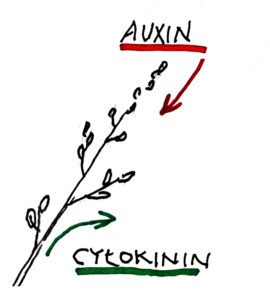Rhythmical Pruning and Spraying to Enhance Medicinal and Culinary Properties
By Dennis Klocek 4 min read

In the growth of medicinal and culinary plants the balance between two fundamental hormonal influences is a valuable key to enhancing both medicinal properties as well as aromatics and flavour in culinary plants.
Most plants are apically dominant. That means that the terminal buds on each branch determine the branching and shooting form of the plant as well as the pollen and pollen tube formation of the flowers. The hormone that regulates that is known as auxin.
Auxin is produced in terminal buds and flows down from leaf to petiole to stem. Where the petiole of a leaf meets the stem a bud forms in the axis in higher plants that has the potential to laterally shoot into a whole branch.
It is prevented from doing that by the flow of auxin from the apical bud. If it were to shoot prematurely it would clog the center of the plant with too many leaves and the ability of the plant to receive sunlight would be diminished. The vertically oriented apical bud produces auxin to regulate the tendency for horizontal growth from the buds in the leaf axils. This is apical dominance under the influence of auxin.
The hormone that stimulates a lateral bud to shoot is cytokinin. This is produced in the roots and flows upwards to the cambium and under the right conditions causes the buds in the leaf axils to unfold their own shoot that is covered with leaf and bud repetitions. This is the shooting of the greenwood in many perennials. It is regulated by cytokinin as is the side branching of the root radicle descending out of a germinating seed. These two hormones are supported by a whole other host of hormones but it is possible to say that they are the most fundamental plant gesture determinants.
At first glance it seems as if some plants that are strongly dominated by auxin might have a superabundance of auxin. In reality auxin and cytokinin are present simultaneously in the most minute and intimate relationships in the plant tissues. A slight shift in the hormonal profiles of a growing plant allows for the economy of the plant to build structures that allow it to function optimally in its particular ecologic niche.
This is where the practice of prune and spray can be very effective in the production of terpenes that characterize many medicinal plants as well as many culinary plants (i.e. linalool in lavender, limonene in lemon). This is because of the way that plants shift focus from growth to flowering. Growth is generally characterized by water-soluble substances. Flowering and fruiting is generally characterized by lipid or oil-soluble substances. Of course, there are many exceptions but this general principle holds the key to regulating plant formative patterns through a season in order that the shift to terpene chemistry can be maximized.
When a medicinal or culinary plant is harvested or pruned this activity sets up a cascade of hormonal stress response chemistry by radically changing the structural dynamic of the shoot. The harvest takes away the auxin source in the terminal bud that was sending auxin down the phloem, from the leaf, to the stem. The bud that is now uppermost in the cut shoot that is still on the plant has become an apical bud.
Buds that were previously buried in the cambium of the leaf axil receive less auxin. This allows the flow of cytokinin from the xylem to tip the scales in the direction of horizontal growth. This in turn creates many more buds along the shoot because the lateral dominance has overcome the vertical dominance. Many buds in a plant will eventually provide many flower buds (more flower buds also means more fruits in a culinary plant). The flower buds when opening and being fructified are the switch that sends the plant into terpene production. More buds also means more essential oils. The question is how to make this happen in a natural way.
Since the pruned plant wants to go into horizontal mode, a spray made from cytokinin-rich plant materials provides the impetus for a pruned medicinal or culinary plant to become capable of producing an abundance of flower buds. The spray made from plant materials is applied in a very fine mist in a regular rhythm to the pruned plant. The cytokinin can then work in a very subtle way to gradually move the plant into a growth pattern that produces a harmonious unfolding of inflorescences.
The key is to use substances like: coconut water, molasses, fava bean extracts, and pollens to create a ferment that preserves the hormonal vitality of the cytokinin. When applied in very small amounts in a rhythmic way the spray allows the plant to transition from growth to reproduction while maintaining a harmony of parts. This makes the flowering and subsequent terpene production highly productive. Careful observation of the physiological changes in the growing plant can give the grower insight into how the sprays are working on a given plant.
The goal is to keep the delicate balance between cytokinin and auxin well within the species pattern but at the same time provide a daily finely divided foliar dose of cytokinin to offset the apical dominant form. This balance prolongs the formation of the anthers in flowers that signal the production of terpenes in the plant.
—
For more on this, please see Gems and Plants for Healing Chronic Illness – Greenwood Gathering a video presentation of these concepts, or join us in Gem and Plant August-September 2023 to learn how to make your own plant sprays.

Dennis Klocek
Dennis Klocek, MFA, is co-founder of the Coros Institute, an internationally renowned lecturer, and teacher. He is the author of nine books, including the newly released Colors of the Soul; Esoteric Physiology and also Sacred Agriculture: The Alchemy of Biodynamics. He regularly shares his alchemical, spiritual, and scientific insights at soilsoulandspirit.com.
2 Comments
Leave a Comment
Similar Writings
Experimental Process for Enhancing Drought Tolerance and Fungus Resistance in Plants
In the life of a plant alcohols play an important role in the maturation and fruiting process. They also form the basis for the protective wax cuticle that keeps the plant free from insect and fungus attack. Plant wax in the form of the cuticle surrounding the surfaces of leaves and stems of plants also…
Video: Sustainable Garden Harvesting – Fennel Harvesting Tips
Instead of one-and-done harvesting for the market, learn to harvest fennel so that your garden plants last all through the season. Plus, tips to winterize your organic veggies so they don’t rot when the rains come.
Thank you Dennis for this very clear and concise picture of what would otherwise seem very complicated and for helping to clarify the relationships of polarity governing the growth and medicinal properties of the plants.
I am looking forward to exploring these principles further in the upcoming Gem and Plant course and benefiting from additional guidance in order to better put these principles into practice.
Dear Ben
Lovely to see you collaborating with your dad. I’ve always referred to Denis as the best teacher I ever had. I was fortunate to be in the second year of Goethean Science. I wonder what your haky sack jug count maxed out at. I think you were going for 100 maybe? Terpens are a wonder. Ive had a bamboo farm for 20 years I’ve got 30 varieties. My wife and I will retire to Portugal a year from next March. So we put the farm up for sale. 8.97 acres about 3-4 in bamboo. I only mention it because I could tap the potential of a bamboo plantation with my stock of rhizomes and starts. Or even just a screen for something. I used 11 starts in front of an indoor riding arena and disappeared it in 4 years. You could not see the building standing 20′ away on the road. Rhizome costs $15/ ft. And is the cheapest way to buy bamboo. I’d love to see someone make a good start of bamboo before we sell out. Peace be always with you and your wonderful father. Give Denis my regards
love John Deaton